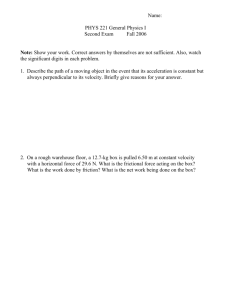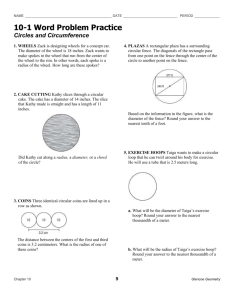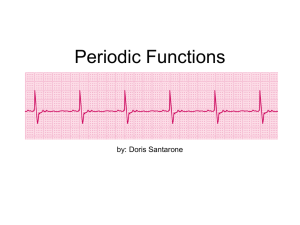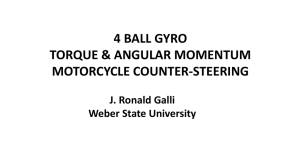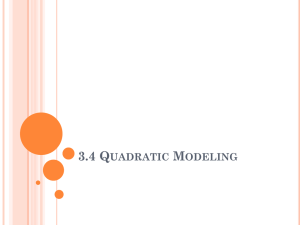Welcome to the Geometry Amazing Race, a journey
advertisement
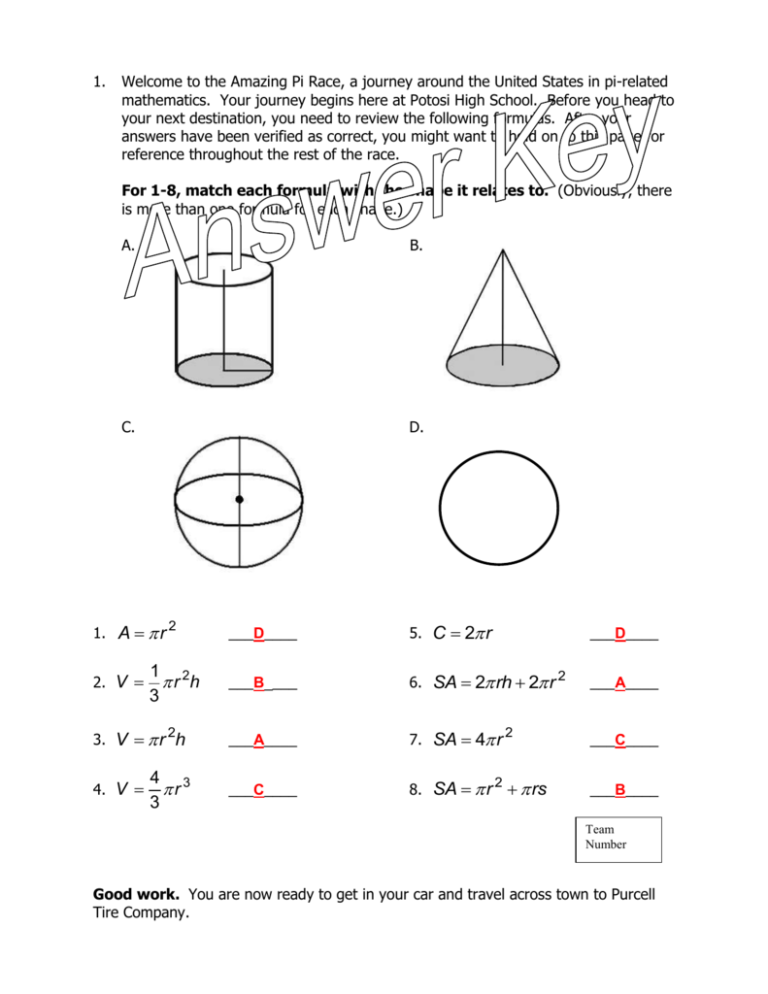
1. Welcome to the Amazing Pi Race, a journey around the United States in pi-related mathematics. Your journey begins here at Potosi High School. Before you head to your next destination, you need to review the following formulas. After your answers have been verified as correct, you might want to hold on to this page for reference throughout the rest of the race. For 1-8, match each formula with the shape it relates to. (Obviously, there is more than one formula for each shape.) A. B. C. D. 2 ___D____ 5. C 2 r 1 2 r h 3 ___B____ 6. SA 2 rh 2 r 2 ___A____ 7. SA 4 r 4 3 r 3 ___C____ 8. SA r rs 1. A r 2. V 3. V r h 4. V ___D____ 2 2 2 ___A____ ___C____ ___B____ Team Number Good work. You are now ready to get in your car and travel across town to Purcell Tire Company. 2. Welcome to the corporate headquarters of Purcell Tire Company in Potosi, MO. Some of the largest tires ever made are produced by Purcell. These tires are used on earthmovers in the mining industry. The overall diameter of one of the tires is 158 inches. If an earthmover had tires that size, how far would it have traveled when the tires rotated 5 times? (Give your answer correct to the nearest tenth of a yard.) Team Number ANSWER: 68.9 yards (circumference) 158 x 5 = 790 in / 36 68.9 yards Congratulations. Now you are ready to drive a couple of hours up the road to St. Louis. 3. Welcome to St. Louis, home of the 1904 World’s Fair. The story is that ice cream cones were invented (or at least popularized) at the 1904 World’s Fair in St. Louis, MO. In St. Louis you will need to take one of the two following DETOURS. After you have completed either one of the problems, bring your work to the check-in location. D1. Suppose the height of a sugar cone is 5 inches and the largest diameter (at the top of the cone) is 2 inches. If a cone is completely filled and then topped with a perfectly hemisphere-shaped scoop, what is the total volume of the ice cream needed? (Round your answer to the nearest tenth.) volume of cone ANSWER: 1 2 1 2 5 7.3 in3 r h (1 )(5) in3 3 3 3 Team volume of hemisphere Number 1 4 3 1 4 2 3 3 r (1 ) in 2 3 2 3 3 5 2 7 7.3 in3 3 3 3 ANSWER: 6.5 in3 Team Number D2. On a standard ice cream cone (shaped sort of like 2 stacked cylinders) the top section has a diameter of 1¾ inches and a height of 1 inch. For the bottom section both the diameter and the height measure 1½ inches. If a cone is completely filled and then topped with a perfectly hemisphere-shaped scoop, what is the total volume of the ice cream needed? (Round your answer to the nearest tenth.) volume of top volume of bottom cylinder cylinder 2 2 2 3 r h (.875 )(1) 2.4 in r h (.752 )(1.5) 2.7 in3 volume of hemisphere 1 4 3 1 4 3 3 r (.875 ) 1.4 in 2 3 2 3 2.4 + 2.7 + 1.4 = 6.5 in3 Good work! You’ve completed the detour. Now board a plane for a trip to Seattle, Washington. 4. Welcome to Seattle, home of the Space Needle. This structure was completed in 1962, just before the opening of the World’s Fair in that city. About 500 feet above ground is the revolving Sky City Restaurant. The entire Space Needle saucer does not turn; only a 14-foot wide ring, next to the windows in the restaurant, rotates. The 94.5 foot diameter ring rotates 360 degrees in exactly 47 minutes. Here in Seattle you have two tasks to choose from, a fast forward or a regular task. Fast Forward: If you are the first team to correctly complete this fast forward dealing with angular and linear velocity, you can skip the next city and proceed to the final destination. In miles per hour, what is the linear velocity at which diners seated next to the window travel as they eat? (Round your answer to the ANSWER: nearest hundredth.) .07 mph 94.5 ft 60min 1mile .07 mph 47min 1hr 5280 ft Team Number Congratulations on completing the Fast Forward. Now you can catch the next flight to your final destination, New York City. OR Regular Task: If you could stretch out in a straight line the distance a diner seated next to the window would travel in 23.5 minutes, what would that distance be (to the nearest tenth of a foot)? (1/2 circumference) (0.5)(94.5) = 47.25 ft 148.4 ft ANSWER: 148.4 ft Team Number Good work on this task. Catch a flight to Chicago for your next-to-last task. 5. Welcome to Chicago, home of the first Ferris wheel. George W. Ferris, a bridgebuilder from Pittsburgh, Pennsylvania, designed the Ferris wheel for the 1893 World's Fair. The Chicago Fair's organizers wanted something that would rival the Eiffel Tower that was built for the Paris World's Fair of 1889. Suppose the original Ferris wheel is still standing and one of the members of your team boards that wheel and the other boards the wheel currently standing on Navy Pier in Chicago. Both Ferris wheels start turning at the same time and at the same speed and continue turning until the first time the two of you return to the bottom position at the same time. How many revolutions will each of you have made and how many feet will each of you have traveled? (Round to the nearest whole number.) ANSWER: circumference of 1893 wheel = 250 ft 1893 wheel circumference of 1995 wheel = 140 ft __14____ revolutions LCM = 3500 ft 3500 250 14 revolutions 3500 140 25 revolutions _10,996__ feet 1995 wheel __25____ revolutions 3500 10995.97 ft 10996 ft _10,996__ feet Team Number Great job! Hurry to catch a flight to New York City for your final challenge. 6. Welcome to your final destination -- “The Big Apple,” New York City. Attention focuses on Times Square every New Year’s Eve for the “dropping of the ball.” It was in 1907 that the first New Year's Eve Ball made its descent. The first New Year's Eve Ball, made of iron and wood and adorned with one hundred 25-watt light bulbs, was 5 feet in diameter and weighed 700 pounds. The Ball has been lowered every year since 1907, with the exceptions of 1942 and 1943, when the ceremony was suspended due to the wartime "dimout" of lights in New York City. The 2000-2007 version of the Times Square New Year's Eve Ball, designed by Waterford Crystal, was a geodesic sphere, six feet in diameter, and weighed approximately 1,070 pounds. It was covered with a total of 504 Waterford crystal triangles that varied in size and ranged in length from 4.75 inches to 5.75 inches per side. The new Times Square New Year’s Eve Ball (introduced for bringing in 2008) is a 12 foot geodesic sphere, double the size of previous balls, weighs 11,875 pounds, and is covered in 2,668 Waterford Crystals. Your final challenge has two parts: a. If the shape of the newest ball was a perfect sphere with the diameter given, what would be its surface area? (Leave your answer in terms of , with appropriate units.) ANSWER: 144 ft2 (surface area of sphere) 4r 2 4(62 ) 144 ft2 b. The description says the new ball is double the size of the previous ball. How many times greater is the volume of the new ball than the one used in 2000? radius is twice the size; for volume, radius is cubed; so volume is 23, or 8, times greater than older ball ANSWER: 8 students may also actually calculate both volumes to answer this question CONGRATULATIONS ON COMPLETING THE AMAZING PI RACE! You are team number ________ in order of finish. Team Number
